The first weekend of September I visited Copenhagen Botanical Garden again. As described earlier the garden has a cactus house open to the general public as well as a propagation house that you can't enter. Flowering and otherwise interesting plants are put on display close to the entrance of the propagation house so even though you can't enter you still have a chance to enjoy some of the gems hidden away inside this house. An example is the beautiful flowering Ariocarpus fissuratus pictured below.

Flowering Ariocarpus fissuratus

Ariocarpus fissuratus flower
Lots of interesting plants are on display inside the publicly accessible cactus house. I especially fell for the lone Ariocarpus retusus tucked away among some larger plants.
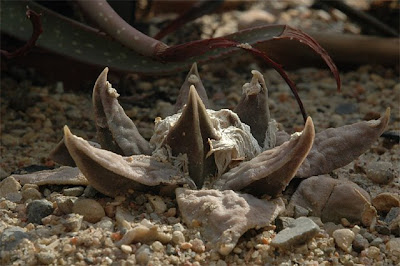
Ariocarpus retusus

Ariocarpus retusus seen from above
Another beauty growing among much larger plants is a (slightly dehydrated) Astrophytum asterias.

Astrophytum asterias
The cactus house holds a large collection of Mammillaria as for example this Mammillaria prolifera var. texana that certainly lives up to its name.

Mammillaria prolifera var. texana
Back in the propagation house a group of Strombocactus disciformis was also on display. The plants are growing in rocks mimicking their natural habitat.

Strombocactus disciformis
My previous post on the Copenhagen Botanical Garden & Museum featured several pictures of the greenhouses so I won't bring any here except for a photo showing the top of the main greenhouse reflected in the water lilly pool in front of it.

Greenhouse reflected in the water lilly pool
Sunday, September 28, 2008
Copenhagen Botanical Garden revisited
Thursday, August 16, 2007
Copenhagen Botanical Garden & Museum
I spent part of my summer vacation in Copenhagen and naturally had to visit the Botanical Garden and Museum. The garden is located in the center of the city and has many visitors. Unlike most other gardens and parks in Copenhagen, the purpose of the botanical garden is research. Therefore, “it is not allowed to run, to ride a bicycle, climb the trees, stay on or walk on the lawns, pick the flowers or picnic.” These rules are a gross limitation on Danes who generally light bonfires and run around naked on lawns ;-)

The Conservatory
The botanical garden was established August 2, 1600, and has moved and changed during the centuries. The fourth and present incarnation of the garden was opened to the public on October 9, 1874, 274 years after the founding of the first botanical garden (the vanes on the conservatory roof date the construction to 1873).
The cactus and succulent plants have their own dedicated greenhouse in these wonderful settings. Facing the stairs leading to the main conservatory building (the palm house), the cactus and succulent house is located to the left of the stairs, one level lower than the palm house.
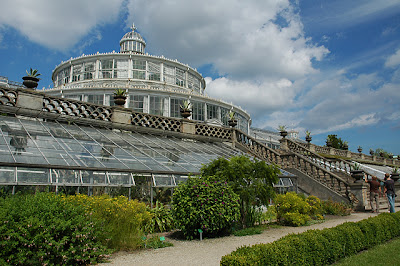
The cactus and succulent house
Inside the cactus house you’ll find an abundance of plants – both small globular types and huge columnar plants. It seems like theft of the smaller plants is a problem as they are protected by glass plates and the whole house is monitored by video.

Inside the cactus and succulent house
The plants all look vigorous and well tended for, as for example this group of flowering Astrophytum ornatum plants (for comparison you can check the A. ornatum growing in the Myriad Botanical Gardens, Oklahoma City).

Flowering Astrophytum ornatum

Astrophytum ornatum flower
A large, fat Astrophytum asterias was hiding in the shadows of the larger plants.

Astrophytum asterias
And a Mammillaria geminispina was displaying its last flowers along with a multitude of dark red fruits.
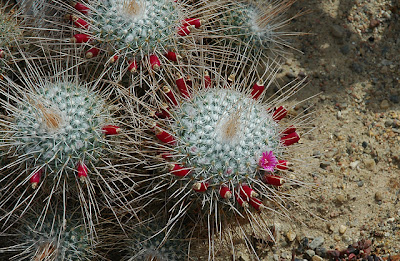
Mammillaria geminispina
Unfortunately I couldn’t find any Lophophora, Ariocarpus, or Strombocactus in the publicly accessible houses; but the garden also has houses that are not open to the public and reserved for experiments and plant propagation. Maybe it’s just wishful thinking, but I’m almost positive I glimpsed a collection of ariocarpi and a few lophs inside one of these houses.
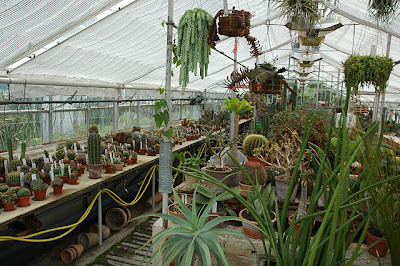
Propagation house – closed to the public
If you happen to be in Copenhagen a visit to the Botanical Garden and Museum is highly recommended. It’s a tranquil oasis situated in the center of a bustling city, and the historical conservatory buildings are beautiful in their own right (the garden was declared a preserved site on January 31, 1977). You might not find a lot of the rarer species in the houses open to the public, but the plants on display are abundant, well grown, and clearly marked.
Wednesday, July 04, 2007
A visit to Myriad Botanical Gardens and Crystal Bridge Tropical Conservatory, Oklahoma City
I recently visited Oklahoma City and had a Sunday to kill. Being within walking distance from my hotel I decided to visit the Myriad Botanical Gardens and Crystal Bridge Tropical Conservatory.
The garden functions as an urban oasis in downtown Oklahoma City with its verdant hills, perennial gardens, and a tranquil lake with koi and lots of turtles sunning themselves. The cylindrical glass shape of the Crystal Bridge Conservatory is hovering above the waters of the lake connecting its shores - a novel and interesting approach to greenhouse construction.

Crystal Bridge Conservatory
While the garden itself and the special architecture of the conservatory merit a visit I was a bit disappointed with the collection of plants kept in the conservatory. The succulent collection (growing on the so-called Dry Mountain) seems like a mishmash of unrelated and mostly unnamed plants (one of the named exceptions being a large Astrophytum ornatum (Monk's Hood)), but I'm probably heavily prejudiced by my expectations to botanical gardens as collections of plants with a scientific scope - not just a look-and-feel-good assemblage of greenery.

Astrophytum ornatum – one of the few named plants

View of the Dry Mountain
Writing this I realized that I've been consistently complaining about the quality of the cactus collections in my posts on botanical gardens – I guess I'll have to arrange a visit to the Desert Botanical Garden (Phoenix, Arizona) in order to see some real plants ;-)
Saturday, January 01, 2000
20. Astrophytum
Lemaire, Cact. Gen. Sp. Nov. 3. 1839.
[Greek asteros, star, in reference to the star-shaped stem cross section of the type species, and phyton, plant]
Allan D. Zimmerman & Bruce D. Parfitt
Plants stem succulents, unbranched [to several branched from base], mostly low and deep-seated in substrate [taller in Mexican species]. Roots diffuse. Stem unsegmented, dark green or gray-green, hemispheric or depressed-spheric [to spheric or short cylindric], (2.5-)6-15(-60)[-100] × 6-10(-20) cm, speckled [or entirely hidden] by numerous tufts of dense, whitish, multicellular hairs less than 0.5 mm; ribs [4-]8-10, crests uninterrupted, straight [to sinuous and/or helically curving around stem], broad and nearly flat or rounded [sharp or keeled]; areoles distinct, [2-]6-9[-20] mm apart along ribs, circular; areolar glands absent; cortex and pith hard, not mucilaginous. Spines absent [1-25 per areole in some Mexican species]. Flowers diurnal, near stem apex, at adaxial edge of areoles, funnelform, 4.5-5.4[-8] × 3.8-5.2[-6] cm; inner tepals yellow, proximally red [all yellow], 25 × 6-10[-12] mm, margins entire; ovary sparsely to densely scaly, axils spineless long hairy with arachnoid trichomes, distal scales spine-tipped; stigma lobes [8-]10-12, yellow [pale yellowish], 4 mm. Fruits indehiscent or splitting irregularly, green or pinkish to red, ovoid to spheric, 15-20 × 12 mm, initially fleshy, drying immediately after ripening, sparsely to densely scaly with spine-tipped scales; axils of scales long woolly, spineless; floral remnant persistent. Seeds dark brown to blackish, appearing hollow or bowl-shaped from strongly expanded, inrolled rim around sunken hilum, 2-3 mm in greatest dimension, nearly smooth; testa cells very slightly convex. x = 11.
Species 4-5 (1 in the flora): sw United States, Mexico.
Astrophytum is most often recognized as a distinct genus. Chloroplast DNA evidence (C. A. Butterworth et al. 2002), however, confirms that it is among the closest relatives of Echinocactus. Unlike Echinocactus, the stem surfaces of Astrophytum species are speckled by numerous tiny white tufts of minute, matted hairs in addition to the regularly spaced woolly areoles.
1. Astrophytum asterias (Zuccarini) Lemaire, Cactées. 50. 1868.
Star-peyote, star cactus, sea-urchin cactus
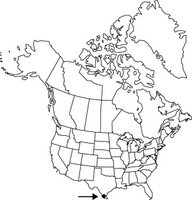 Echinocactus asterias Zuccarini, Abh. Math.-Phys. Cl. Königl. Bayer. Akad. Wiss. 4(2): 13. 1845
Echinocactus asterias Zuccarini, Abh. Math.-Phys. Cl. Königl. Bayer. Akad. Wiss. 4(2): 13. 1845
Plants flat-topped and usually flush with soil surface, or at most, above-ground portion low, dome-shaped. Stems shiny, sparsely speckled by bright white extra-areolar hair tufts 0.5-1 mm diam.; ribs usually 8, straight, very low, nearly flat or rounded; areoles 3-5 mm diam., with yellow or gray wool. Flowers opening widely, externally long woolly; inner tepals lanceolate, acuminate. 2n = 22.
Flowering Mar-May and sporadically after summer rainfall. Grasslands, shrublands, Tamaulipan thorn scrub, gravelly slopes and deep soil of flats; of conservation concern; 20-100 m; Tex.; Mexico (Nuevo León, Tamaulipas).
The vernacular name of Astrophytum asterias, star-peyote, reflects its superficial similarity to peyote, Lophophora williamsii, which has very soft, uniformly pale blue-green stems quite unlike the hard, speckled, almost shiny, green stem surface in A. asterias. Astrophytum asterias is extremely rare and localized north of Mexico, presently known only from Starr County, Texas.

Back to online articles.
The Flora of North America web site.
All Time Most Popular Posts
-
Lophophora williamsii (peyote) populations have diminished in large areas of South Texas where peyoteros harvest the cactus for ceremonial ...
-
On various occasions I've been asked what growing media I'm using for my cactus plants. I don't have a set soil mix recipe as su...
-
Below is a list of retailers/nurseries selling cactus seed and plants. I've only listed vendors I've done business with. If you ar...
-
Most cacti are easily grown from seed - and with a little patience and care they can be grown into beautiful plants. Lophophora williamsi...
-
In last month’s post on the troubled Texan peyoteros I referred to Anderson’s article on the peyote situation in Texas. Given the importanc...
-
Yet another slightly off topic and probably not entirely politically correct post, but I couldn’t help noticing the similarity of my monstr...
-
Flowering stand of San Pedro cacti (Trichocereus pachanoi) To me the main draw of the San Pedro cactus ( Trichocereus pachanoi (syn. Ech...
-
In the June 2008 issue of the Cactus & Co magazine Jaroslav Šnicer, Jaroslav Bohata, and Vojtěch Myšák described a new Lophophora spec...
-
There seems to be an increased focus on the alarming Texas peyote situation. A couple of weeks ago the Houston Press published a mournful, i...
-
I spent two weeks working in Delhi, India during January. I had one weekend off and had planned to spend it in Delhi at my own leisure, but ...


















